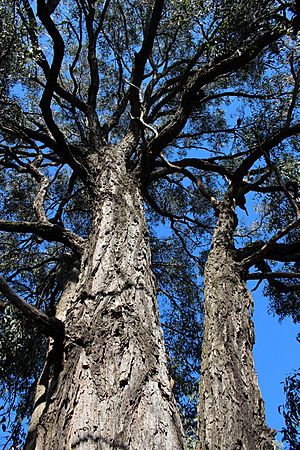Beyer's ironbark facts for kids
Quick facts for kids Beyer's ironbark |
|
|---|---|
 |
|
| Eucalyptus beyeriana in Norfolk Reserve, Greenacre | |
| Scientific classification | |
| Genus: |
Eucalyptus
|
| Species: |
beyeriana
|
| Synonyms | |
|
Eucalyptus panda subsp. illaquens L.A.S.Johnson |
|
Eucalyptus beyeriana, commonly known as Beyer's ironbark, is a small tree. It is found only in New South Wales, Australia. This tree has dark grey to black bark that looks and feels like iron. It has long, narrow adult leaves, white flowers, and small, woody fruits. Scientists sometimes discuss its name, as it is similar to another tree called Eucalyptus beyeri.
What Does Beyer's Ironbark Look Like?
Beyer's ironbark is a tree that can grow to be about 20 to 25 meters (65 to 82 feet) tall. It has rough, dark grey to black bark on its trunk and branches. This bark is called "ironbark."
Young plants and new shoots have lance-shaped leaves. These leaves are about 55 to 90 mm (2 to 3.5 inches) long and 10 to 15 mm (0.4 to 0.6 inches) wide. Adult leaves are also lance-shaped. They are longer, about 70 to 140 mm (2.8 to 5.5 inches) long and 7 to 20 mm (0.3 to 0.8 inches) wide. Both sides of the adult leaves are a dull green color.
The flowers grow in groups of seven. Each group is on a short stalk about 5 to 10 mm (0.2 to 0.4 inches) long. The individual flower buds are oval or diamond-shaped. They are about 4 to 5 mm (0.16 to 0.20 inches) long. The flowers are white and bloom between August and November. After flowering, the tree produces woody, cup-shaped or cone-shaped fruits. These fruits are about 3 to 6 mm (0.12 to 0.24 inches) long and wide.
How Was It Named?
Eucalyptus beyeriana was first officially described in 1990. Two botanists, Lawrie Johnson and Ken Hill, wrote its description. They studied a tree found near Wallacia.
Johnson and Hill believed that this tree had been mistaken for another species, Eucalyptus beyeri. They thought the original E. beyeri was actually a hybrid (a mix of two different plants). Because of this, they gave the tree a new name, E. beyeriana. Today, Eucalyptus beyeri is known as Eucalyptus × beyeri. However, some other botanists, like Ian Brooker, still use the name E. beyeri for this tree.
The names beyeriana and beyeri honor George Beyer. He was an assistant at the Sydney Technological Museum. He helped Richard Thomas Baker, who first described E. beyeri.
Where Does Beyer's Ironbark Grow?
Beyer's ironbark grows in woodlands. It prefers poor soil. You can find it in New South Wales, from Narrabri in the north down to Nowra in the south.

